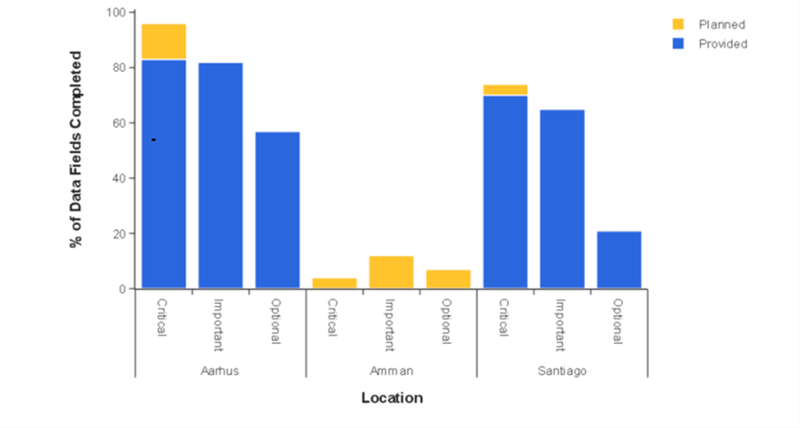Urbanization has surged in recent decades, transforming cities worldwide into bustling hubs of activity and innovation. However, amidst this growth, a silent yet significant threat looms: urban water runoff (UWR). After a heavy rainfall, the streets glisten under city lights, but beneath the surface, rainwater rushes over impermeable pavements, picking up pollutants, debris, and contaminants along the way. This runoff flows into rivers and streams, contaminating water sources and posing risks to public health and ecosystem integrity.
In response to these imperatives, pioneering initiatives such as WATERUN have embarked on a mission to advance novel methodologies aimed at revolutionizing urban water runoff management on its different case studies sites (Santiago de Compostela, Aarhus and Amman).
In celebration of Girls in ICT Day, WATERUN aims to explain these innovative solutions to raise awareness about the crucial role of Information and Communication Technologies (ICT) in managing urban water runoff. This article discusses the intricacies of urban water runoff management and explores the innovative solutions from Geographic Information Systems (GIS) to advanced numerical modeling, open data platforms, and Artificial Intelligence (AI). Additionally, it presents their implementation in the Amman case study to illustrate the real-world application and benefits of these technologies.
Innovative solutions
Geographic Information Systems (GIS) play a pivotal role in mapping and analyzing high-risk areas prone to urban water runoff. By integrating geographical data with spatial analysis tools, GIS enables urban planners to identify vulnerable zones and prioritize intervention strategies. From pinpointing areas susceptible to flooding to assessing land use patterns affecting runoff rates, GIS provides valuable insights for proactive management of UWR.
Advanced numerical modeling techniques are indispensable for predicting and optimizing water flow in urban areas. These models simulate complex hydrological processes, such as rainfall-runoff interactions and surface water dynamics, to forecast UWR patterns with precision. By accurately predicting runoff volumes and pathways, numerical modeling aids in designing effective drainage systems, mitigating flood risks, and optimizing stormwater management practices in urban environments.
Open data platforms serve as collaborative hubs for sharing and accessing critical information relevant to UWR management. These platforms facilitate transparent data exchange among stakeholders, including urban water management authorities, researchers, and the public. By promoting data transparency and accessibility, open data platforms empower stakeholders to make informed decisions, foster interdisciplinary collaboration, and develop evidence-based strategies for mitigating UWR impacts on water quality and urban ecosystems.
Artificial Intelligence (AI) technologies harness the power of machine learning and big data analytics to revolutionize UWR management. AI algorithms analyze vast datasets, including sensor data, satellite imagery, and weather forecasts, to identify patterns, trends, and anomalies related to UWR dynamics. By leveraging AI-driven insights, it is possible to proactively identify UWR hotspots, optimize stormwater infrastructure investments, and implement targeted interventions to mitigate pollution and enhance urban resilience against flooding events.
By adopting these innovative solutions, cities can enhance their resilience, protect water resources, and promote sustainable urban development in the face of evolving climate and environmental pressures.
The Amman Case Study
Integrating the Amman Case Study (CS) into the discussion enriches our understanding of the real-world application of innovative solutions in urban water runoff management. Amman, the main city of Jordan, presents a compelling scenario characterized by Mediterranean climate conditions and significant challenges in managing UWR while sustaining its urban development.
The initiatives undertaken in the Amman CS align closely with the innovative solutions presented. The implementation of diffuse pollution monitoring by the University of Jordan and the development of the urban hydrology model following the principles of managing stormwater at the block scale by UFZ directly correspond to the utilization of Geographic Information Systems (GIS) and advanced numerical modeling techniques. GIS enables the mapping and analysis of high-risk areas prone to UWR, while numerical modeling helps predict and optimize water flow patterns in urban areas.
However, one of the key challenges faced in the Amman CS is the lack of data on sewer networks, which complicates the setup of hydraulic models. According to a report by the Helmholtz Centre for Environmental Research (UFZ), "no sewer network data was available, making it impossible to set up the hydraulic model component." Despite this limitation, the project leverages global open-source data to build models focusing on the hydrologic aspects of the case study. This reliance on open data platforms underscores the necessity of accessible, transparent data sharing for effective UWR management.

Figure 1: Summary of the data project partners provided in each CS, UFZ
Another critical issue encountered in the Amman CS is the unavailability of ERA5-Land hourly rainfall data, which hinders the feasibility of detailed modeling by TUB, the technical partner in charge of implementing Clean City Cover, an interactive web-based map tool that focuses on of urban water runoff (UWR) management plans in cities based on the Water-Sensitive Urban Design (WSUD) concept.
The absence of data highlights the ongoing challenge of data scarcity in urban water management projects and the need for robust data collection and sharing frameworks. Overall, the Amman CS serves as a practical demonstration of how innovative methodologies, such as GIS, numerical modeling, and collaborative platforms, can be applied to address UWR challenges in real-world urban contexts.
Authors: Marie-Paule ADDE, Office International de l’Eau, mp.adde@oieau.fr (22/05/2024)